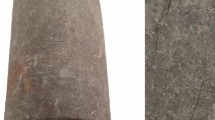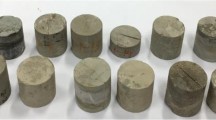Application of traditional rock physics experimental methods in investigating the macroscopic pertrophysical properties of low porosity, low permeability, and high complexity pore structure reservoirs is limited by the high cost, long cycle, large error, and specific difficulties of such reservoirs. It is also difficult to evaluate quantitatively the influence of microscopic reservoir structure on rock physical properties. Application of micro-CT scanning and advanced imaging processing technology enables one to establish an accurate representative pore space model equivalent to the true core structure. Numerical simulation with Avizo-XLab solver method was used to calculate the pore fluid flow based on the Navier-Stokes equation and the Darcy seepage law. The visualization method helped to display the pore-space fluid flow in a three-dimensional streamline, and the pore pressure distribution field is displayed, making the simulation results clear and intuitive. Research shows that numerical simulation based on the digital platform provides an instrument for the measurement of the fluid micro flow and the rock seepage parameters. This paper provides a new method for digital research on rock physical properties which helps to overcome the deficiency of traditional rock physics experimental research.






Similar content being viewed by others

References
J. H. Schon, Physical Properties of Rocks: Fundamentals and Principles of Petrophysics, Elsevier (2015).
T. N. Narasimhan and P. A. Witherspoon, “An integrated finite difference method for analyzing fluid flow in porous media,” Water. Resour Res., 12(1), 57-64 (1976).
W. Lin, X. Li, Z. Yang et al., “Construction of dual pore 3-D digital cores with a hybrid method combined with physical experiment method and numerical reconstruction method,” Transp. Porous Media, 120(1), 227-238(2017).
Y. Zhao, G. Zhu, C. Zhang, et al., “Pore-scale reconstruction and simulation of non-Darcy flow in synthetic porous rocks,” J. Geophys. Res.: Solid Earth, 123(4), 2770-2786 (2018).
S. An, J. Yao, Y. Yang et al., “Influence of pore structure parameters on flow characteristics based on a digital rock and the pore network model,” J. Nat. Gas Sci. Eng., 31,156-163 (2016).
S. Zhou, G. Yen, H. Xue, et al., “2D and 3D nanopore characterization of gas shale in Longmaxi formation based on FIB-SEM,” Marine Pet. Geol., 73,174-180 (2016).
G. Zhou, L. Qiu, W. Zhang, et al., “Simulation analysis on water’s micro seepage laws under different pressure gradients using computed tomography method,” Adv Civ. Eng., 2018 (2018).
A. Li, W. Ding, J. He, et al., “Investigation of pore structure and fractal characteristics of organic-rich shale reservoirs: a case study of lower Cambrian Qiongzhusi Formation in Malong block of Eastern Yunnan Province, South China,” Mar. Pet. Geol., 70, 46-57 (2016).
S. M. Alizadeh, S. Latham, J. Middleton, et al., “Regional analysis techniques for integrating experimental and numerical measurements of transport properties of reservoir rocks,” Adv. Water Res., 100, 48-61 (2017).
H. Deng, J. Sun, N. Golsanami, et al., “A method to construct high precision complex pore digital rock,” J Geophys. Eng., 15(6), 2695-2703 (2018).
S. Kelly, H. El-Sobky, C. Torres-Verdin, et al., “Assessing the utility of FIB-SEAS images for shale digital rock physics,” Adv. Water Res., 95, 302-316 (2016).
Y. Zhao, G. Zhu, Y. Dong, et al., “Comparison of low-field NMR and microfocus X-ray computed tomography in fractal characterization of pores in artificial cores,” J. Fuel, 210, 217-226 (2017).
N. Zhang, F. Zhao, P. Guo, et al., “Nanoscale pore structure characterization and permeability of mudpacks and fine-grained sandstones in coal reservoirs by scanning electron microscopy, mercury intrusion porosimetry, and low-field nuclear magnetic resonance,” J. Geofluids, 2018 (2018).
Y. Yang, C. Wang, J. Yao, et al., “A new voxel upscaling method based on digital rock,” Int. J. Multiscale Comput. Eng., 13(4), (2015).
C. Li, Y. Fang, and Y. Ju, “Three-dimensional reconstruction of coal’s microstructure using randomly packing-sphere and pore-growing and lattice Boltzmann method,” J. Nanosci. Nanotechol., 17(9), 6867-6872(2017).
J. Liu. Y. Wang, and R. Song, “A pore scale flow simulation of reconstructed model based on the micro seepage experiment,” J. Geofluids, 2017 (2017).
Author information
Authors and Affiliations
Corresponding author
Additional information
Translated from Khimiya i Tekhnologiya Topliv i Masel, No. 6, pp. 66 – 70, November – December, 2019.
Rights and permissions
About this article
Cite this article
Liang, Z., Wang, C. & Zhou, Y. Analysis of Seepage Characteristics of Complex Pore Structure Rock by Digital Core Method. Chem Technol Fuels Oils 55, 756–764 (2020). https://doi.org/10.1007/s10553-020-01091-0
Published:
Issue Date:
DOI: https://doi.org/10.1007/s10553-020-01091-0



